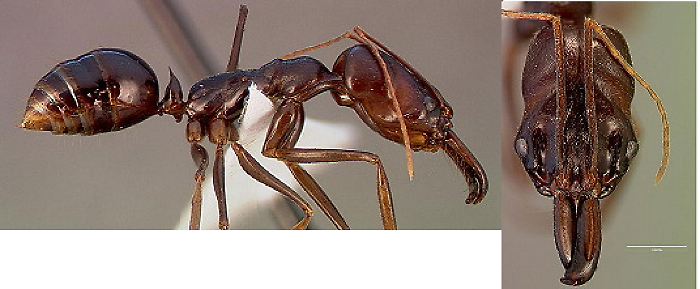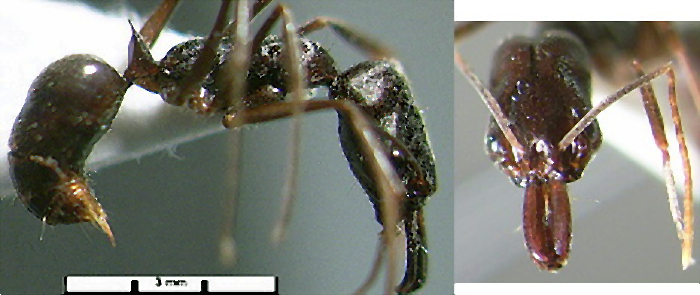SUBFAMILY PONERINAE - Genus Odontomachus
| The Ants of
Africa SUBFAMILY PONERINAE - Genus Odontomachus |
|
| Contents - Ponerinae - PONERINAE Introduction |
 Genus Odontomachus Latreille (1804: 179)
Genus Odontomachus Latreille (1804: 179)In Tribe PONERINI.
Diagnostic Features - Mandibles elongate, linear, inserted close to the midline of the anterior margin of the head. When closed the mandibles meet throughout their length but the active ant characteristically keeps the mandibles wide open to form a line at right angles to the long axis of the head. The mandibular apex is armed with three teeth in a vertical series, the dorsal tooth being truncated. The node of the petiole ends dorsally in a long spine.
The genus was fully revised by Brown (1976a), who defined a total of 51 species - 28 from the Old World, of which only two are African, and 23 from the New World. Interestingly, despite there being only two modern species, he thought that the genus originated in the Old World wet tropics, with a relatively late dispersal. The snap action of the mandibular strike is a common characteristic of genus members and is among the fastest movements known from anywhere in the animal kingdom (Hölldobler & Wilson, 1994). Although the action may be primarily a strike for capture, it also provides a very effective backward propulsion when the mandibles are snapped onto a hard surface, as Lang had commented - "the leaping may be of some practical use to the ants when scaly ant-eaters open their nests" (in Wheeler, 1922).
Separation of African species (Brown, 1976a):-
| 1 |  Occiput with no more than a fine longitudinal groove or
sulcus; first gastric segment glassy smooth, without appreciable
pubescence, but usually with a few coarse hairs; petiolar node and
posterior part of second gastric tergum prevailingly smooth and
shining; petiole node generally higher and narrower in profile Occiput with no more than a fine longitudinal groove or
sulcus; first gastric segment glassy smooth, without appreciable
pubescence, but usually with a few coarse hairs; petiolar node and
posterior part of second gastric tergum prevailingly smooth and
shining; petiole node generally higher and narrower in profile |
assiniensis |
| -- |  Occiput with a distinct longitudinal groove; first gastric
tergum with abundant and conspicuous appressed to decumbent pubescence;
sides of petiolar node and (usually) all of gastric tergum finely
striate or reticulate Occiput with a distinct longitudinal groove; first gastric
tergum with abundant and conspicuous appressed to decumbent pubescence;
sides of petiolar node and (usually) all of gastric tergum finely
striate or reticulate |
troglodytes |
| PONERINAE Introduction |
© 2007, 2012 - Brian Taylor CBiol FSB FRES 11, Grazingfield, Wilford, Nottingham, NG11 7FN, U.K. |
href="odontomachus.htm"